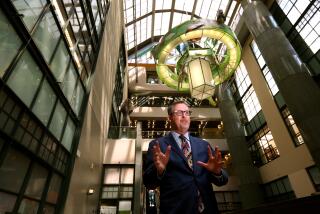N.Y. Library, 81 Branches to Have a Major Face Lift
- Share via
Outside the New York Public Library, the two guardian lions crouch on their pedestals, their impassive stares challenging all who enter what library chairman Andrew Heiskell calls “the people’s university.”
The New York Public Library, generally considered one of America’s greatest libraries, was formed by the consolidation of three private libraries--the Astor, the Lenox and the Tilden--in 1885. The building the lions guard took nine years and more than $9 million to build and was dedicated on May 23, 1911.
Last week, inside the massive beaux-arts building of white marble, the board of trustees announced a new goal of refurbishing what clearly has become a national intellectual treasure. Their plan is to raise $307 million over five years. The money will be used to refurbish the main library and its 81 branch libraries as well as its collection of over 4 million books.
Author Toni Morrison, a library trustee, spoke at the campaign kickoff, saying that libraries are centers of civilization and that knowledge is “not a gift but a necessity--it’s what we are born for.”
“Humans pursue and transfer learning,” she said, and “great civilizations create ways to codify and preserve knowledge.”
Not Enough
She stressed, however, that it was not enough for civilizations to gather knowledge.
“When the preserved forms become the domain of the few . . . chaos follows such parsimony.” For a civilization to remain great, she continued, all must have free access to information.
Whitney North Seymour Jr., a member of the New York Public Library’s Branch Libraries Council, told the board that if the central libraries were the bastions of civilization, then “the branch libraries are civilization’s outreach programs.”
Others who spoke included New York City Mayor Edward I. Koch, actor Eli Wallach, and David Rockefeller, former chairman of Chase Manhattan Bank, who said that “without a strong, ongoing source of information, a society will die.”
Also present was actor Ozzie Davis, who first acted in the small theater of a branch library in upper Manhattan, and spoke in praise of The Schomburg Center for Research in Black Culture, which is supported by the NYPL. Author and historian David McCullough called the library his second home and asked “what price are we willing to pay to pass the torch in better condition than we found it? Will we rise to the occasion? And what an occasion!”
The money-raising campaign was conceived in the late 1970s when, as honorary board chairman Brooke Astor put it, “we decided we had to have more money.”
Heiskell, a former chairman and chief operating officer of Time, Inc., said the campaign would be a “partnership between the public and private sector,” as was the library’s conception. He revealed that $170 million had already been pledged from as varied sources as AT&T;, the National Endowment for the Arts, and the Ford Foundation.
More to Read
Sign up for Essential California
The most important California stories and recommendations in your inbox every morning.
You may occasionally receive promotional content from the Los Angeles Times.











